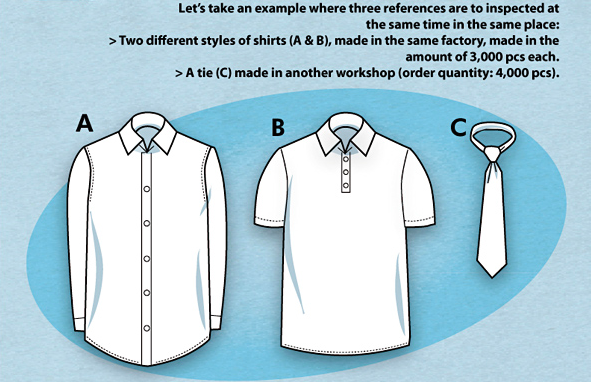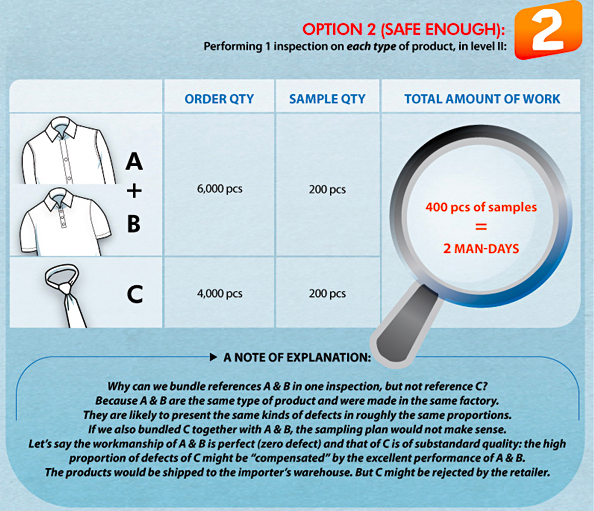There is one concept in quality inspections that is quite simple and yet widely misunderstood: the sampling lot.
The ISO 2859 standard calls it a “lot”. It may or may not include different products based on how different they are.
Let’s take an example with 3 products. (I pulled this from an old infographic about sampling plans.)
As the buyer, you might decide to run 3 separate inspections. 1 per product.
Or you may decide to bundle several products together in 1 lot. (That’s what many people call “combined sampling“.) In this case the sampling of the 2 styles of shirts is combined.
In this case it probably makes sense. The materials & accessories are pretty much the same. The production processes are also nearly identical. Therefore it probably fits the definition of “items of a single type, grade, class, size and composition, manufactured under uniform conditions at essentially the same time” (ISO 2859).
(Some people would take issue with that. They might ask whether these 2 styles are made on different sewing lines. And that’s a valid point since there can be a huge difference in workmanship quality between 2 sewing lines in the same workshop.)
However, there are cases where combined sampling represents very high risks! Let’s cover two common cases.
Case 1: product quality is not stable, yet
Let’s say you buy 2 models of electric bikes. Some of the parts are different, but it’s about 90% similar.
And let’s say you just launched mass production. There is no track record of low-defect-rate production. It’s a new product, and there are MANY ways they might go wrong. That means, for such a complex product, it’s quite probable that something WILL go wrong…
If you combine them in 1 sample lot, interpreting the results (which models is OK and which one is not good) may not be easy. I’d strongly encourage the buyer to do 2 separate inspections.
Let’s go straight to case 2, and you will understand why it’s good to separate the 2 models in 2 lots if one wants to have easy-to-interpret findings.
Case 2: the products are too different from each other
I described such a case in Bundling different products in one inspection: danger!.
A client has ordered 100 pillows and 600 pillow covers. He decides to do only 1 inspection, and to bundle these 2 products for the AQL check. The total number of products is 700 pcs.
Under level II (which is chosen most often), the code letter is J.
J corresponds to 80 pcs to check. It is feasible in 1 man-day.
Among these 80 samples, how many are pillows, and how many are pillow covers? In principle the proportion must be the same as the total quantity:
- 80 x 100/700 = 11 pillows
- 80 x 600/700 = 69 pillow covers
The acceptability limits are: 5 major defects and 7 minor defects. In my example, the inspector finds:
- 4 major defects on the pillows, and none on the pillow covers.
- 5 minor defects on the pillows, and 2 on the pillow covers.
He adds up the numbers, and he is inside the limits. Based on this inspection protocol, it is impossible to reject the goods.
However, the smart reader will think “4 major defects on 11 pcs checked? The pillows are obviously not sellable.” And that’s right. The inspector found 36% of the pillows with a major defect!
Yet the other product “compensated” with a much lower proportion of the defects, and the client can’t easily tell the supplier to rework the pillows.
I wrote before about the limits of random inspections based on AQL limits. I shot a video (on Youtube)that explains why these statistics are in favor of the supplier. And yet, random inspections are not a bad tool. Very often there are no better alternatives.
Make sure you use this tool properly. And, as always, it means you need to get the fundamentals right:
- Make the right choices for sampling calculations. No combined sampling when it’s not applicable.
- Do all the counting & sampling work properly at the beginning of the inspection.





